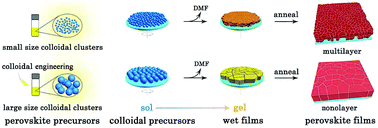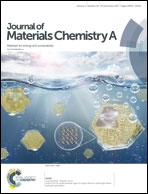Colloidal engineering for monolayer CH3NH3PbI3 films toward high performance perovskite solar cells†
Abstract
It is very significant to understand the formation of perovskite crystals from the precursor solution and construct high-quality films to achieve highly efficient perovskite solar cells (PSCs). Here, we have revealed a colloidal strategy to prepare compact monolayer perovskite films by controlling the size of colloidal clusters in the perovskite precursor. Under the action of the coordination interaction, the introduction of CH3NH3Cl (MACl) into the standard perovskite precursor significantly increases the size of colloidal clusters. Meanwhile, N-dimethyl sulfoxide (DMSO) is further employed to stabilize the characteristics of the colloidal clusters and improve the reproducibility of the anti-solvent method. The large colloidal clusters can be orderly arranged on the substrate by spin-coating to form intermediate phase monolayer films, which grow to form large grains with an average size of 3 μm. Due to the much lower trap-state density and higher crystallinity of the monolayer perovskite films, a power conversion efficiency (PCE) of 19.14% has been achieved. This study sheds light on the conversion mechanism of perovskite crystals from the colloidal precursor to solid films, and paves the way for further improvement of high-quality perovskite films that can lead to high performance devices.

- This article is part of the themed collection: 2017 Journal of Materials Chemistry A HOT Papers


 Please wait while we load your content...
Please wait while we load your content...